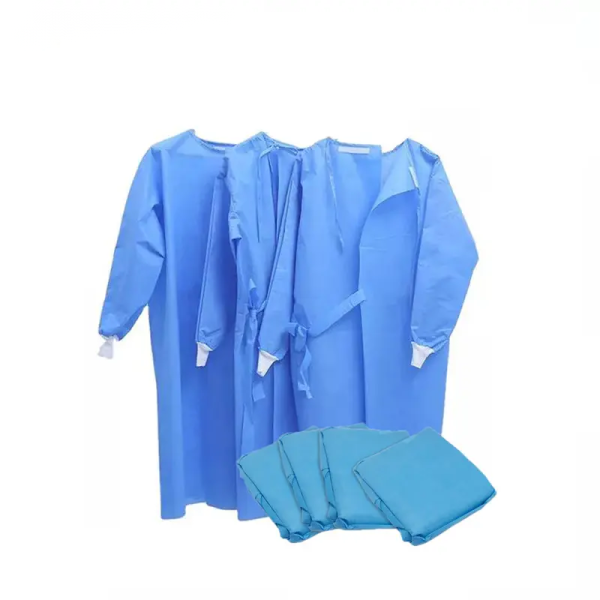Modern Innovations in Surgical Gown Manufacturing
Introduction
In the world of medical science, surgical gowns have served as a protective barrier for healthcare professionals for over a century. Their evolution from simple, woven cotton garments to the highly sophisticated designs we see today embodies a journey of technological advancement and innovation. This comprehensive article delves into the modern innovations transforming the surgical gown manufacturing industry.
Section I: The Advent of Non-Woven Fabrics: A Material Revolution
One of the most transformative shifts in surgical gown manufacturing is the transition from traditional woven fabrics like cotton to advanced non-woven materials. In the earlier days of surgery, healthcare professionals donned cotton gowns, which offered limited protection and did not hold up well to repeated sterilization and wear.
However, with the advent of non-woven fabrics such as spunlace nonwoven and SMMS (spunbond-meltblown-meltblown-spunbond), the surgical gown manufacturing industry underwent a revolution. These materials, unlike their woven counterparts, offer superior fluid resistance, optimal breathability, and enhanced comfort, transforming the manufacturing process.
A significant innovation within this category is the incorporation of microfibers into non-woven fabrics. These microfibers, due to their small diameter, provide a more efficient barrier against bacteria and liquids, enhancing the protective nature of surgical gowns.
Another innovation is the addition of synthetic fibers, such as polyester and polyethylene, which have brought about improved durability, resilience, and enhanced protective qualities to surgical gowns.
Section II: Single-Use Solutions: The Emergence of Disposable Surgical Gowns
The 1960s and 70s witnessed the emergence of disposable surgical gowns, marking a transformative shift in the surgical gown industry. Created from lightweight, non-woven synthetic materials, these single-use gowns presented a cost-effective, time-saving alternative to traditional reusable gowns.
The concept of disposability eliminated risks associated with reusing gowns, such as potential cross-contamination, while also circumventing the need for repeated cleaning and sterilization. This innovation proved to be a significant stride forward in ensuring patient safety and improving workflow efficiency within healthcare settings.
Section III: Function Meets Comfort: Innovations in Gown Design
The past few decades have seen considerable advancements in surgical gown design, with a dual focus on enhancing user comfort and functionality while maintaining rigorous standards of protection. Modern gowns now feature adjustable necklines for better fit, thumb loops to prevent sleeve ride-up during procedures, and ties and tape tabs for secure closure.
Moreover, to cater to the diverse body sizes of healthcare professionals and ensure ease of movement during long, complex surgeries, gown designs have incorporated overlapping back panels and generous cuts. In parallel, ultrasonic seam technology strengthens gown seams, enhancing durability and protection.
Section IV: Personalized Protection: Reinforced and Specialist Gowns
Another modern innovation transforming surgical gown manufacturing is the development of reinforced and specialist gowns. Recognizing that the risk of contamination varies with the nature of the surgical procedure, manufacturers introduced these gowns to provide a tailored defense.
Reinforced gowns offer superior protection in critical areas and are designed to endure high-risk, high-fluid procedures. Specialist gowns, on the other hand, cater to specific types of surgeries, offering the right balance of comfort and protection for each scenario. These personalized solutions minimize the risk of contamination and infection transmission, providing an additional layer of safety.
Section V: The Extra Defense: Antimicrobial-Coated Surgical Gowns
Antimicrobial-coated gowns serve as the latest chapter in the story of surgical gown evolution. These gowns undergo treatment with antimicrobial substances that kill or inhibit the growth of microorganisms, thus adding an extra layer of protection against potential pathogens. This innovative step represents a proactive approach to infection control and augments the preventive measures already in place.
Section VI: The Dawn of the Future: Smart Gowns
Another groundbreaking innovation poised to shape the surgical gown industry is the introduction of smart textiles. With technology permeating every aspect of our lives, the concept of ‘smart gowns’ is no longer confined to the realm of science fiction.
Smart gowns integrate sensors and conductive textiles, potentially capable of monitoring vital signs, detecting contamination, or even releasing antimicrobial agents when required. By providing real-time data and responsive capabilities, these gowns can alert healthcare professionals to potential risks, ushering in a new era of patient safety and infection control.
Section VII: A Greener Outlook: Sustainable Practices in Surgical Gown Manufacturing
The modern surgical gown industry is not just focused on functionality and protection; it is also cognizant of its environmental responsibilities. Recognizing the immense waste generated by disposable gowns, manufacturers are now moving towards sustainable solutions.
The development of eco-friendly, biodegradable surgical gowns represents a significant step towards sustainable healthcare. These gowns, while maintaining high standards of infection control, aim to reduce the environmental impact of healthcare activities, thus ensuring the industry’s sustainability.
Conclusion
From the simple cotton gowns of yesteryears to the advanced, feature-rich designs of today, the surgical gown manufacturing industry has come a long way. Modern innovations are continually refining the production process, enhancing protective features, and making surgical gowns more user-friendly.
Moreover, the industry’s focus on sustainability demonstrates a commitment to reducing the environmental impact of healthcare. As we move forward, we can expect even more exciting innovations in surgical gown manufacturing, ultimately better serving healthcare professionals and patients alike.
Please visit our website for more product details https://medposnonwoven.com/product/surgical-gown-disposable/

